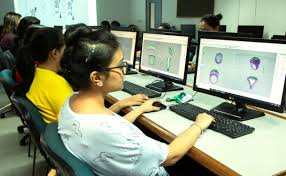Engraver – Gemstone Processing
SECTOR: GEMS & JEWELLERY
SUB-SECTOR: Gemstone Processing
OCCUPATION: Gemstone Faceting and Polishing
REFERENCE ID: G&J/Q6702
ALIGNED TO: NCO-2015/7313.1900
Brief Job Description: The individual works with high-speed rotating machines
and individual sets of hand-made tools to etch out patterns on gemstones for
further polishing and use in jewellery making. It is a traditional and highly
creative role. The person is also called, ‘Naqquashi maker’, the Engraver carves
out different types of patterns on precious and semi-precious gemstones.
Personal Attributes: The job requires the individual to have: creativity; attention
to details; good eyesight; firm grip; ability to work for longer duration with
correct sitting posture while performing a task.
Keywords /Terms Description
Sector Sector is a conglomeration of different business operations having similar
business and interests. It may also be defined as a distinct subset of the
economy whose components share similar characteristics and interests.
Sub-sector Sub-sector is derived from a further breakdown based on the characteristics
and interests of its components.
Occupation Occupation is a set of job roles, which perform similar/ related set of functions
in an industry.
Job role Job role defines a unique set of functions that together form a unique
employment opportunity in an organization.
Occupational Standards
(OS)
OS specify the standards of performance an individual must achieve when
carrying out a function in the workplace, together with the knowledge and
understanding they need to meet that standard consistently. Occupational
Standards are applicable both in the Indian and global contexts.
Performance Criteria Performance criteria are statements that together specify the standard of
performance required when carrying out a task.
National Occupational
Standards (OS)
NOS are occupational standards which apply uniquely in the Indian context.
Qualifications Pack (QP) QP comprises the set of OS, together with the educational, training and other
criteria required to perform a job role. A QP is assigned a unique qualifications
pack code.
Unit Code Unit code is a unique identifier for an Occupational Standard, which is denoted
by an ‘N’
Unit Title Unit title gives a clear overall statement about what the incumbent should be
able to do.
Description Description gives a short summary of the unit content. This would be helpful to
anyone searching on a database to verify that this is the appropriate OS they
are looking for.
Scope Scope is a set of statements specifying the range of variables that an individual
may have to deal with in carrying out the function which have a critical impact
on quality of performance required.
Knowledge and
Understanding
Knowledge and understanding are statements which together specify the
technical, generic, professional and organizational specific knowledge that an
individual needs in order to perform to the required standard.
Organizational Context Organizational context includes the way the organization is structured and how
it operates, including the extent of operative knowledge managers have of their
relevant areas of responsibility.
Technical Knowledge Technical knowledge is the specific knowledge needed to accomplish specific
designated responsibilities.
Core Skills/ Generic
Skills
Core skills or generic skills are a group of skills that are the key to learning and
working in today’s world. In the context of the OS, these include
communication related skills that are applicable to most job roles.
Keywords /Terms Description
NOS National Occupational Standard(s)
NSQF National Skills Qualifications Framework
QP Qualifications Pack
Unit Code G&J/N6705
Unit Title
(Task) Carve patterns on gemstones
Description This OS unit is about carving design patterns on gemstones by using hand and
machine tools
Scope This unit/task covers the following:
Checking bag of faceted gemstones received from supervisor
Carving and etching patterns on the gemstone
Polishing and calibrating the carved gemstone
Maintaining Quality
Achieving productivity
Performance Criteria(PC) w.r.t. the Scope
Element Performance Criteria
Checking bag of
faceted gemstones
received from
supervisor
To be competent, the user/individual on the job must be able to:
PC1. match the stone type, weight and number as mentioned on the bag
PC2. check shape and size of stone as per job sheet for symmetry, colour defects
and potential problems in carving process
PC3. check the permitted level of stone loss
PC4. comprehend the type of stone to be polished either as soft or hard,
transparent, translucent or opaque
Carving and etching
patterns on the
gemstone
PC5. mark design pattern on the stone as per the design given on the job sheet to
be carved and ensure the same is followed thorough out the process
PC6. select the appropriate hand or machine tool with required speed to be used
for carving
PC7. select rotating machine’s speed for the type of stone, tool and pattern
PC8. use water jet to reduce adverse effect of overheating of stone, such as
change of colour or breakage
PC9. maintain and calibrate for shape, size of the gemstones as per design
PC10. avoid damage to any facets that were previously created
PC11. use correct lap, powder and buff
PC12. ensure to attain maximum number of QC approved carved gemstones
Polishing and
calibrating the carved
gemstone
PC13. select the buffing plate to be used for the stone type such as cloth, wool,
wood according to the stone hardness and colour changing properties and
polish
PC14. calibrate the gemstone as per job sheet and allowed losses
Maintaining Quality PC15. return the carved gemstones for quality check
PC16. return any damaged stones
PC17. rework based on feedback from Quality Control department
Achieving
productivity
PC18. meet the target for the number of carved stones per day
PC19. deliver scratch-less and well-polished stones as per job sheet
PC20. maintain stone loss within prescribed limits, particularly, in precious stones
PC21. create new designs in accordance with changing customer preferences and
company’s targets
Knowledge and Understanding (K)
A. Organizational
Context
(knowledge of the
company/organisa
tion and its
process)
The user/individual on the job needs to know and understand:
KA1. company’s policies on: acceptable limits of stone loss, incentives, delivery
standards, safety and hazards, integrity and personnel management
KA2. non-disclosure of “confidential information” provided by the company either
orally or in writing marked as confidential
KA3. liability arising out of loss, theft or inadvertent disclosure of confidential
information
KA4. work flow involved in gemstone processing of company
KA5. importance of the individual’s role in the workflow
KA6. reporting structure
B. Technical
Knowledge
The user/individual on the job needs to know and understand:
KB1. the process of shaping, faceting and polishing
KB2. basic Gemology and properties of different stones
KB3. different types of stones such as precious, semi-precious, synthetic etc.
KB4. market value of stone to understand the rationale for different acceptable
levels of stone loss
KB5. origin of the stone, i.e., which mine it has originated from, particularly,
precious stones to read the softness/ hardness as developed from
precedence of use
KB6. tools to be used for different types of carving and etching and stones
KB7. make different types of pointed tools for etching and carving
KB8. how to maintain rotating machine and tools
KB9. many different types of laps available in terms of material such as diamond or
steel or the grits
KB10. how to use water jet and keep the stone cool
KB11. how to use different types of buff for different stone types such as wool,
wood, and leather and buffing powders such as chrome oxide
KB12. how to work in a safe environment, i.e., without injuries
Skills (S) [Optional]
A. Core Skills/
Generic Skills
Writing Skills
The user/ individual on the job needs to know and understand how to:
SA1. report any stone loss via documentation as per company policy
Reading Skills
SA2. read height, weight, dimensions of the stones as given on job sheets
SA3. read company rules and compliance documents required to complete the
work
Oral Communication (Listening and Speaking skills)
SA4. receive instructions and materials from reporting supervisor
SA5. give feedback to supervisor or co-workers on any specific stone handling
requirement
SA6. share work load when multiple deliverables are required
B. Professional Skills Decision Making
The user/individual on the job needs to know and understand:
SB1. decide on correct use of machines, tools and consumables for carving
Plan and Organize
SB2. plan and organize the work bench for efficient working
Customer Centricity
SB3. adhere to specification, as required by the customer
Problem Solving
SB4. resolve the problem faced, by referring to reporting authority
SB5. deliver carved stones in time by reporting problems faced or anticipated well
in advance
SB6. create new tools for new design patterns, if necessary
SB7. control Losses during engravings
Analytical Thinking
SB8. convert the stone plan on job sheet to a carved and polished stone
SB9. spot difficulties with respect to practicality of plan or facets created
SB10. improve work processes or greater productivity
Critical Thinking
SB11. spot process disruption and reasons for delay
Unit Code G&J/N9901
Unit Title
(Task) Coordinate with others
Description This OS unit is about communicating with colleagues, seniors and outside parties in
order to achieve the deliverables on schedule
Scope This unit/task covers the following:
Interacting with supervisor
Interacting with colleagues within and outside the department
Interacting with outside parties
Performance Criteria(PC) w.r.t. the Scope
Element Performance Criteria
Interacting with
supervisor
To be competent, the user/individual on the job must be able to:
PC1. coordinate for receiving work instructions and raw materials from reporting
supervisor
PC2. communicate to the reporting supervisor about process flow improvements,
product defects received from previous process, repairs and maintenance of
tools and machinery as required
PC3. communicate to reporting supervisor about operation details and hazards
PC4. interact with supervisor regarding compliance of company policy and rules
Interacting with
colleagues within and
outside the
department
PC5. coordinate with colleagues to share work, as per the workload in order to
achieve team goals
PC6. communicate and discuss work flow related difficulties in order to find
solutions with mutual agreement
PC7. coordinate and receive feedback from quality control department
PC8. resolve conflicts by communicating with colleagues and other departments
PC9. coordinate with colleagues regarding multitasking in other departments as
per the requirements
Interacting with
outside parties
PC10. adhere to nondisclosure policy of the company in all outside coordination
Knowledge and Understanding (K)
A. Organizational
Context
(knowledge of the
company/organisation
and its process)
The user/individual on the job needs to know and understand:
KA1. company’s policies on: preferred language of communication, reporting and
escalation policy, quality delivery standards and personnel management
KA2. company’s policies on non-disclosure of “confidential information” provided
by the company either orally or in writing marked as confidential
KA3. liability arising out of loss, theft or inadvertent disclosure of confidential
information
KA4. reporting structure
B. Technical
Knowledge
The user/individual on the job needs to know and understand:
KB1. various categories of people that one is required to communicate and
coordinate within the organization
KB2. importance of effective communication in the workplace like expressing and
addressing grievances appropriately and effectively
KB3. importance of teamwork in organization and individual success
KB4. various components of effective communication
KB5. barriers to effective communication
KB6. common reasons for interpersonal conflict
KB7. what constitutes disciplined behavior for a working professional
Skills (S) [Optional]
A. Core Skills/
Generic Skills
Writing Skills
The user/ individual on the job needs to know and understand how to:
SA1. write instructions, remarks, job sheets, basic information, technical details
etc. in preferred local language of communication and English
Reading Skills
SA2. read preferred language of communication as prescribed by the company
SA3. read job sheets and interpret technical details mentioned in the job sheet
Oral Communication (Listening and Speaking skills)
SA4. discuss task lists, schedules, and work-loads with co-workers
SA5. be a good listener
SA6. be effective in communicating the issues faced, to the supervisor
SA7. avoid using jargon, slang or acronyms when communicating
B. Professional Skills Decision Making
The user/individual on the job needs to know and understand:
SB1. spot and communicate potential areas of disruptions in the work process and
report the same
SB2. report supervisor or deal with a colleague individually, depending on the type
of concern
Plan and Organize
SB3. to plan work for maximum productivity
SB4. to plan and organize the schedule for maintenance of tools and machines
Customer Centricity
SB5. convey accurate information to relevant internal as well as external
customers
Problem Solving
SB6. how to handle critical situations caused due to communication issues at
workplace and solve problems without blaming others
Analytical Thinking
SB7. analyse the work processes by interacting with others and adopting best
practices
SB8. use prior experience to observe and reflect for development of ideas
Critical Thinking
SB9. think through the problem, evaluate the possible solution(s) and suggest an
optimum /best possible solution(s)
SB10. deal with clients lacking the technical background to solve the problem on
their own
SB11. spot process disruptions and delays and report and communicate with
solutions
SB12. identify immediate or temporary solutions to resolve delays
SB13. apply, analyze, and evaluate the information gathered from observation,
experience, reasoning, or communication, as a guide to thought and action
Unit Code G&J/N9902
Unit Title
(Task) Maintain health and safety at workplace
Description This OS unit is about being aware of, communicating and taking steps towards
minimizing potential hazards and dangers of accidents on the job and maintaining
health and safety at workplace
Scope This unit/task covers the following:
Health and safety in work area
Fire safety
Emergencies, rescue and first aid procedures
Performance Criteria(PC) w.r.t. the Scope
Element Performance Criteria
Health and safety in
work area
To be competent, the user/individual on the job must be able to:
PC1. identify and use appropriate protective clothing/equipment for specific
tasks and work
PC2. identify hazardous job activities in his/her job and communicate the
possible causes of risks or accidents in the workplace
PC3. carry out safe working practices while dealing with hazards to ensure
safety of self and others
PC4. identify and avoid doing any tasks or activities in a wrong posture
PC5. practice appropriate working postures to minimise occupational health
related issues
Fire safety PC6. use the appropriate fire extinguishers on different types of fire
PC7. demonstrate rescue techniques applied during fire hazard
PC8. demonstrate good housekeeping in order to prevent fire hazards
PC9. demonstrate the correct use of any fire extinguisher
Emergencies, rescue and
first aid procedures
PC10. provide appropriate first aid procedure to victims wherever required eg.in
case of bleeding, burns, choking, electric shock etc.,
PC11. respond promptly and appropriately to an accident or medical emergency
PC12. participate in emergency procedures such as raising alarm, safe
evacuation etc.,
Knowledge and Understanding (K)
A. Organizational
Context
(knowledge of the
company/organisation
and its process)
The user/individual on the job needs to know and understand:
KA1. company’s policies on: safety and hazards and personnel management
KA2. names and location of documents that refer to health and safety in work
place
KA3. reporting structure
B. Technical Knowledge The user/individual on the job needs to know and understand:
KB1. meaning of “hazards” and risks
KB2. health and safety hazards commonly present in the work place and related
precautions
KB3. various dangers associated with use of electrical equipment
KB4. preventative and remedial actions to be taken in case of exposure to toxic
material
KB5. methods of accident prevention
KB6. how different chemicals react and the related hazards
KB7. how to use machines and tools without causing any accident
KB8. importance of using protective clothing/ equipment while working
KB9. precautionary activities to prevent the fire accident
KB10. various causes of fire
KB11. techniques of using different fire extinguishers
KB12. different materials used for extinguishing fire
KB13. rescue techniques applied during a fire hazard
KB14. various types of safety signs and their meaning
KB15. appropriate basic first aid treatment relevant to different condition e.g.
bleeding, minor burns, eye injuries etc.,
KB16. casualty Lifting in case of an accident caused to a person
Skills (S) [Optional]
A. Core Skills/ Generic
Skills
Writing Skills
The individual on the job needs to know and understand how to:
N.A.
Reading Skills
SA1. read and comprehend basic content to read labels, charts, signage
SA2. read and comprehend basic English to read manuals of operations
Oral Communication (Listening and Speaking skills)
SA3. communicate effectively the risk of not following safety measures
B. Professional Skills Decision Making
The user/individual on the job needs to know and understand:
SB1. respond to emergencies/accidents, by taking an apt and timely decision.
Plan and Organize
SB2. organize work schedule, work area, tools, equipment and material to
minimize health and safety risk
Customer Centricity
N.A.
Problem Solving
SB3. ensure apt action in case of any emergencies, accidents or fire at the work
location
Analytical Thinking
SB4. analyze untoward incidents from the past and implement correct use of
machines, tools or hazardous chemicals
Critical thinking
SB5. critically analyze the processes carried out by self and by colleagues in the
department to spot potential hazards and safety issues
Criteria For Assessment Of Trainees
Job Role Engraver – Gemstone Processing
Qualification Pack G&J/Q6702
Sector Skill Council Gem & Jewellery
Guidelines for Assessment
- Criteria for assessment for each Qualification Pack will be created by the Sector Skill Council. Each Performance
Criteria (PC) will be assigned marks proportional to its importance in NOS. SSC will also lay down proportion of
marks for Theory and Skills Practical for each PC. - The assessment for the theory part will be based on knowledge bank of questions created by the SSC.
- Assessment will be conducted for all compulsory NOS, and where applicable, on the selected elective/option
NOS/set of NOS. - Individual assessment agencies will create practical tests for skill evaluation for candidates at every
examination/training centre. (As per assessment criteria below) - To pass the Qualification Pack, every candidate should score a minimum 70% of aggregate marks to successfully
clear the assessment. - In case of successfully passing only certain number of NOSs, the candidate is eligible to take subsequent
assessment to pass the Qualification Pack. - In case of unsuccessful completion, the trainee may seek reassessment on the Qualification Pack.









